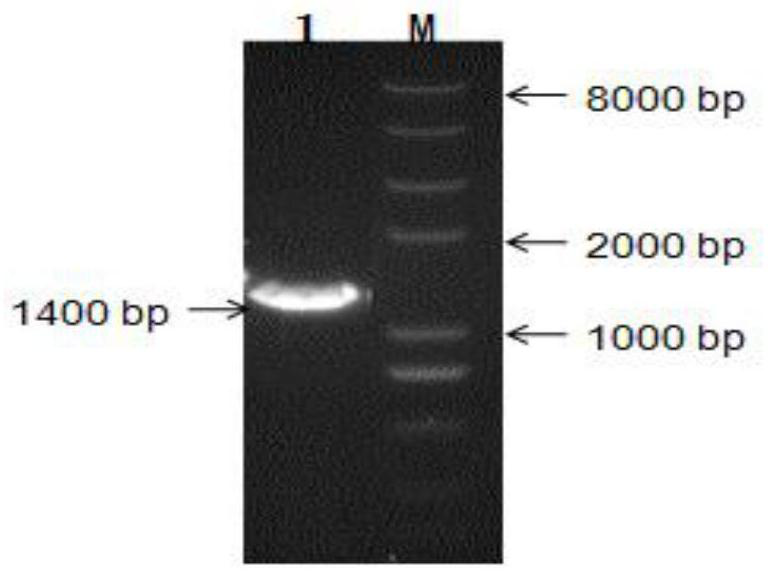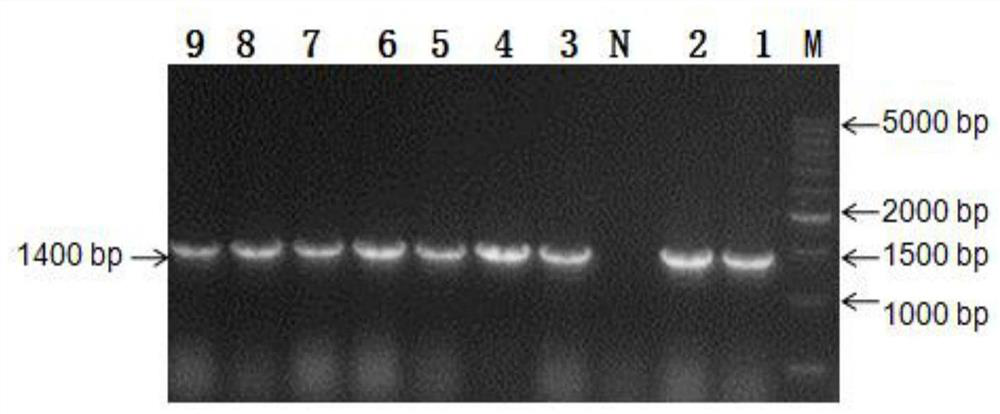Pichia pastoris engineering strain for heterologous expression of cellulase gene CBH II and application
A heterologous expression, Pichia pastoris technology, applied in the direction of microorganism-based methods, peptides containing His tags, enzymes, etc., can solve problems such as difficult manual control and low proportion of cellulase
- Summary
- Abstract
- Description
- Claims
- Application Information
AI Technical Summary
Problems solved by technology
Method used
Image
Examples
Embodiment example 1
[0029] Implementation Case 1 Cloning of target gene
[0030] 1. Take the Trichoderma reesei (Trichoderma reesei QM9414) spore suspension stored in a glycerol tube out of the -80°C refrigerator and thaw it in ice (or 4°C refrigerator) until the spore suspension completely melts. Shake the spore suspension to mix evenly, use an inoculation loop to dip a small amount of bacterial solution, and streak on the PDA medium plate for inoculation. After sealing the plate with parafilm, place it in a 28°C incubator for cultivation. Cultivate for about 5-7 days until the surface of the medium is covered with green spores. The plates were taken out of the incubator and placed in a 4°C refrigerator for later use.
[0031] 2. Inoculate fresh spores on cellulase solid induction culture, spread sterilized cellophane on the surface, and let the culture stand until the hyphae grow out. The hyphae were scraped off from the cellophane and treated with a liquid nitrogen freezer grinder. RNA was ...
Embodiment example 2P
[0037] Implementation case 2 Construction of Ppic9k-CBH Ⅱ expression vector
[0038] 1. Use restriction endonuclease EcoR I / Not I to double-digest pUC18 and cbh2, and use the sticky ends of these two enzymes to connect the vector to the target gene. Prepare the double enzyme digestion system according to Table 2. The metal bath was reacted at 37°C for 50 minutes. After the enzyme digestion was completed, the enzyme digestion product was recovered using a purification recovery kit to remove residual enzymes and oligonucleotides in the enzyme digestion product. The product after double enzyme digestion was reacted with Taq Mix enzyme (volume 1:1) in a PCR instrument at 72°C for 30 min, and A-terminal ligation was carried out.
[0039] Table 2 Double Enzyme Digestion System
[0040]
[0041] 2. After adjusting the molar concentrations of the vector pUC18 and the target gene CBH 2 to roughly the same level, configure the connection system. See Table 3 for the connection system....
Embodiment example 3
[0044] Implementation case 3 Construction of recombinant Pichia pastoris
[0045] 1. Use the restriction endonuclease bglⅡ as the linearization site of the recombinant expression plasmid Ppic9k-CBHⅡ expression vector, perform single enzyme digestion, and prepare a linearization system (see Table 4 for the configuration of the linearization system), mix well, and place in a water bath at 37°C Incubate for 1 hour to achieve circular transformation of the expression vector and to lay the foundation for later transformation. Nucleic acid electrophoresis to verify the linearized plasmid, see Figure 4 . Transformed into Pichia pastoris GS115 competent cells by electrotransformation, and plated to obtain transformants.
[0046] Table 4 Linearization system:
[0047]
[0048] 2. Use the SDS pyrolysis method to roughly extract the genome of the recombinant yeast transformant obtained in 1, and verify its correctness and phenotype by PCR. The nucleic acid map of the genome PCR is...
PUM
 Login to View More
Login to View More Abstract
Description
Claims
Application Information
 Login to View More
Login to View More - R&D
- Intellectual Property
- Life Sciences
- Materials
- Tech Scout
- Unparalleled Data Quality
- Higher Quality Content
- 60% Fewer Hallucinations
Browse by: Latest US Patents, China's latest patents, Technical Efficacy Thesaurus, Application Domain, Technology Topic, Popular Technical Reports.
© 2025 PatSnap. All rights reserved.Legal|Privacy policy|Modern Slavery Act Transparency Statement|Sitemap|About US| Contact US: help@patsnap.com



